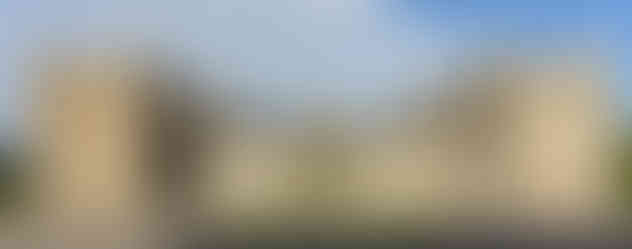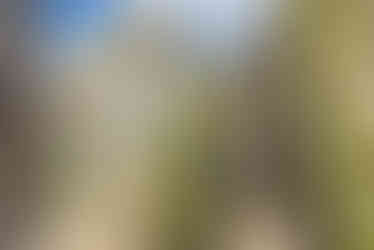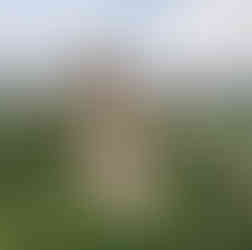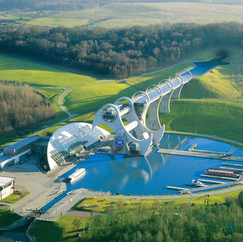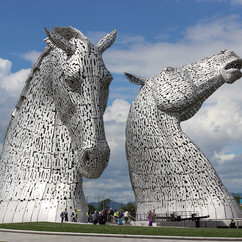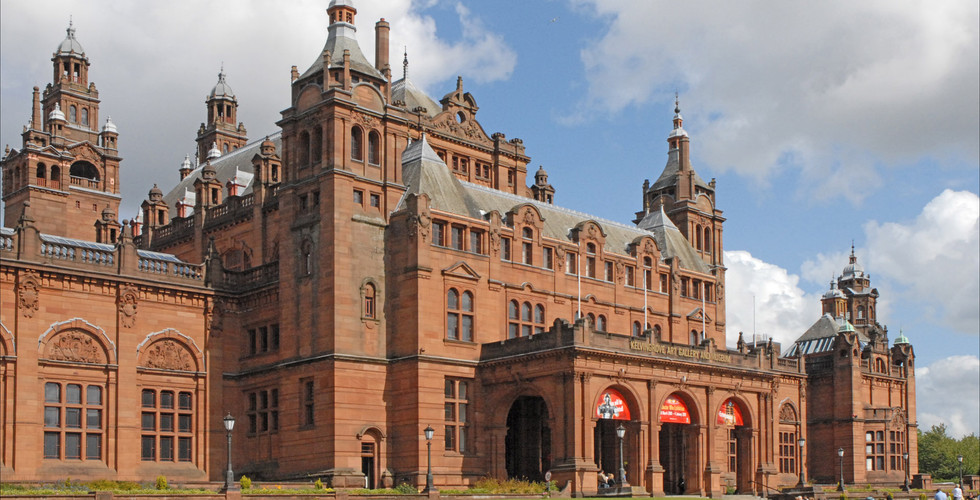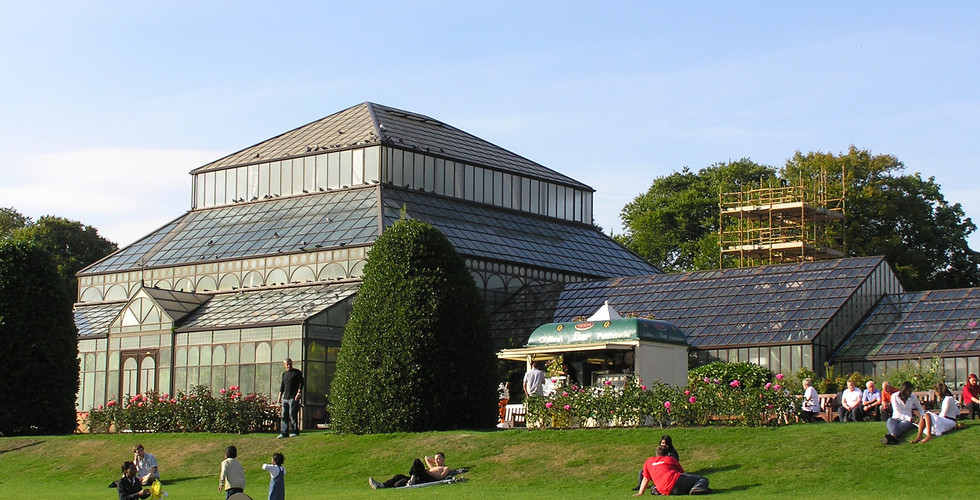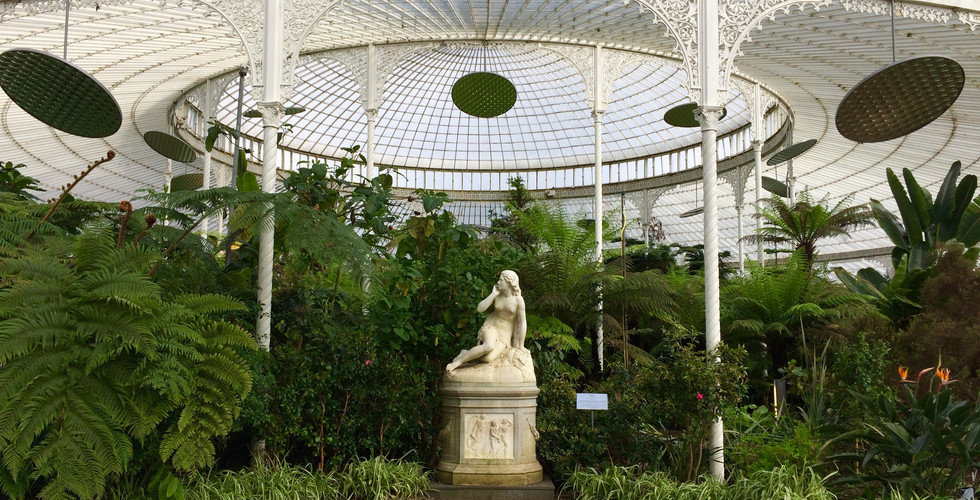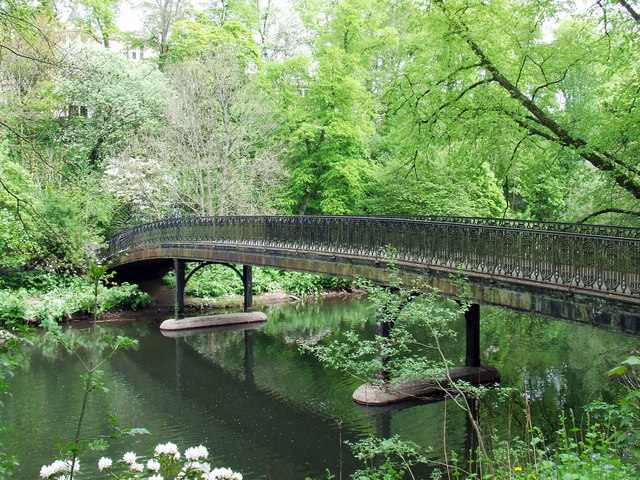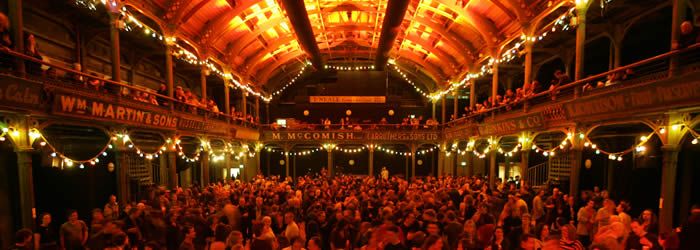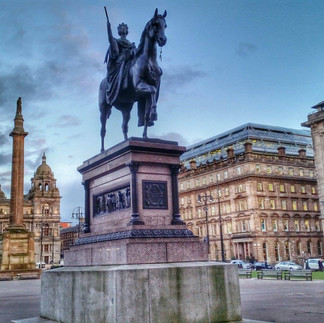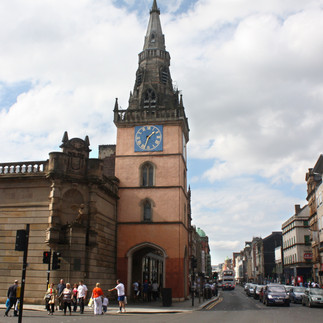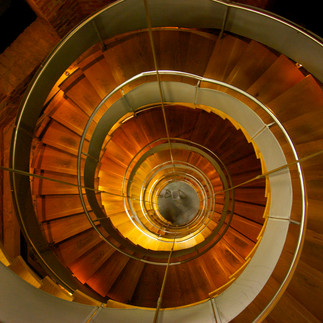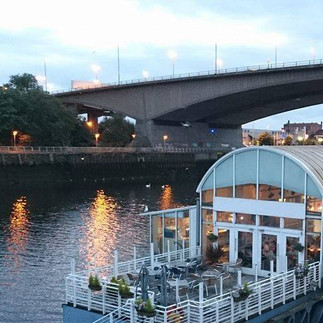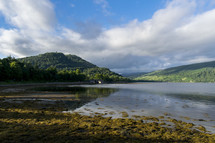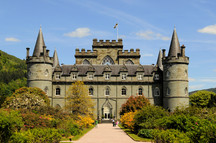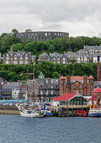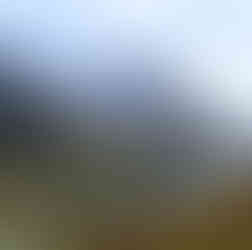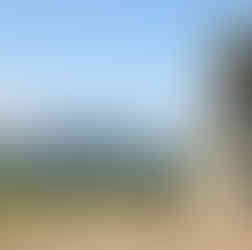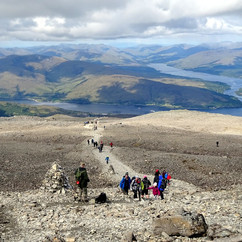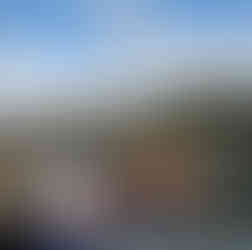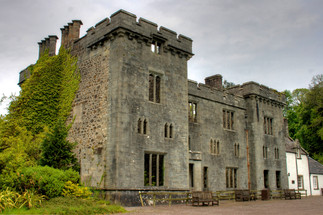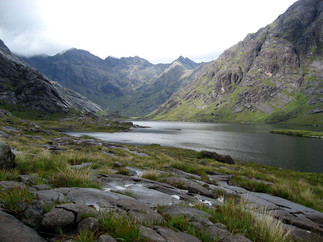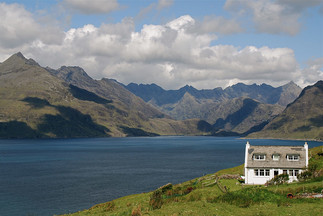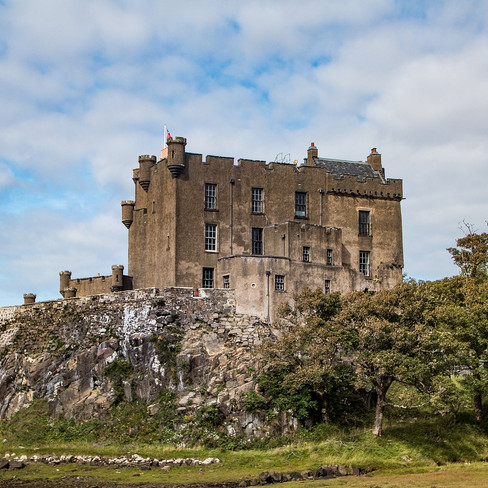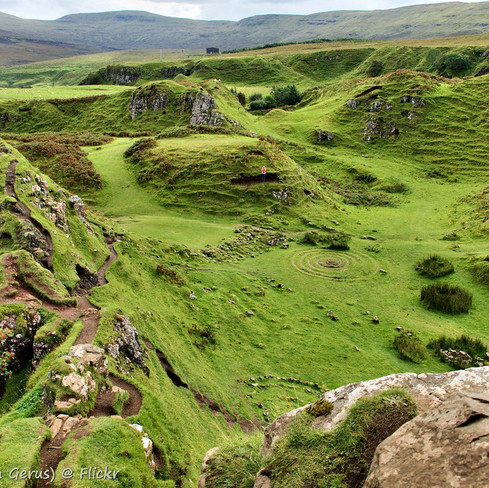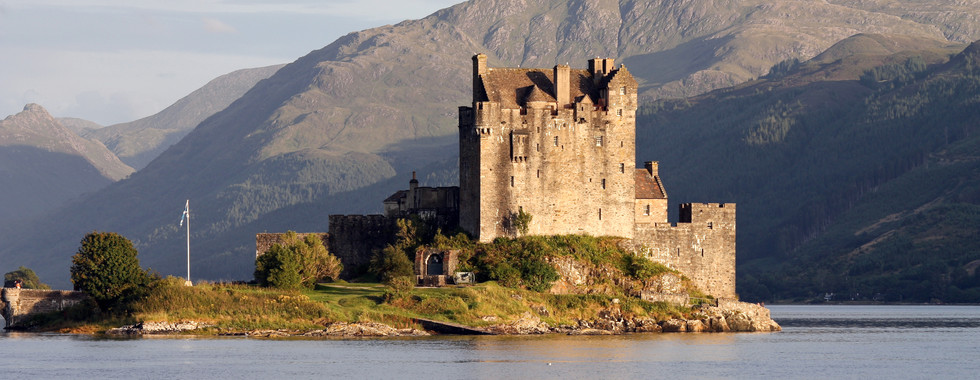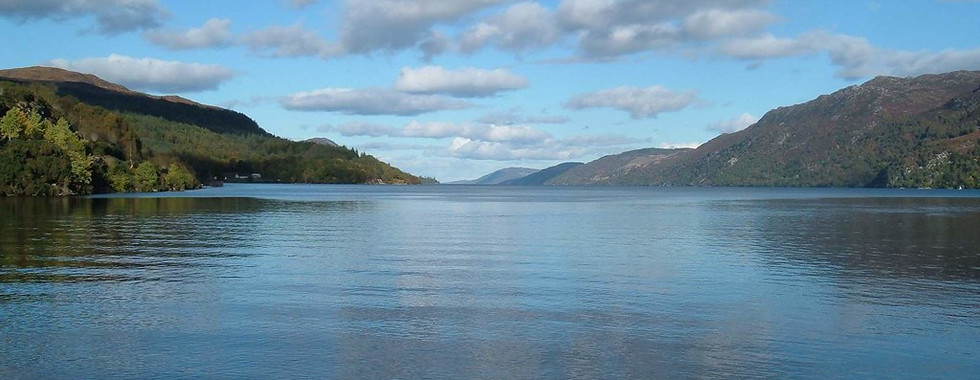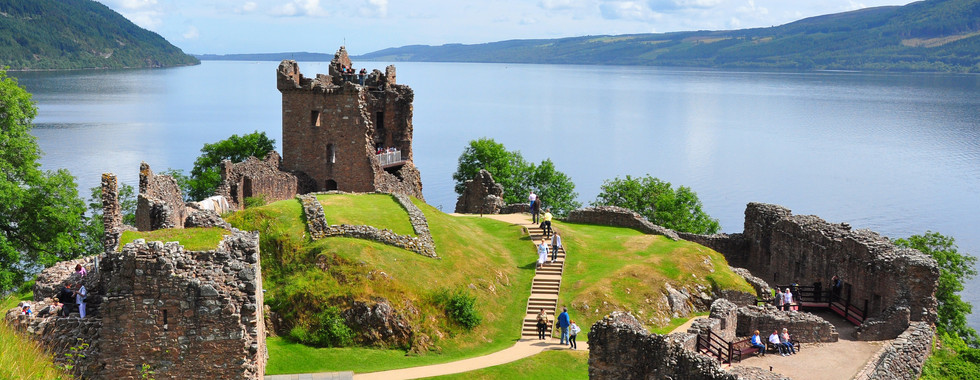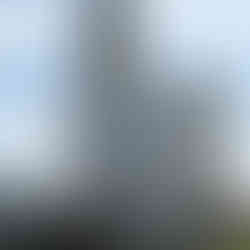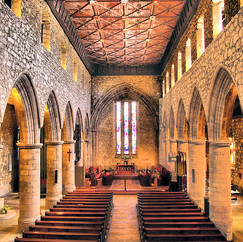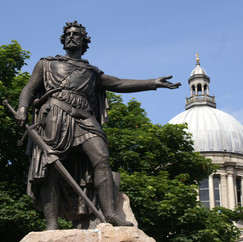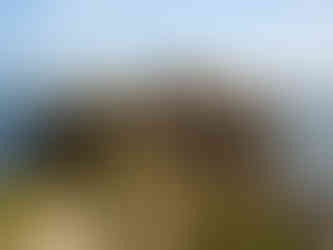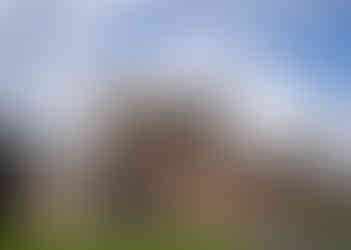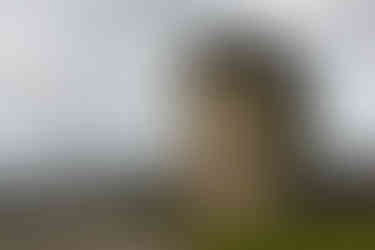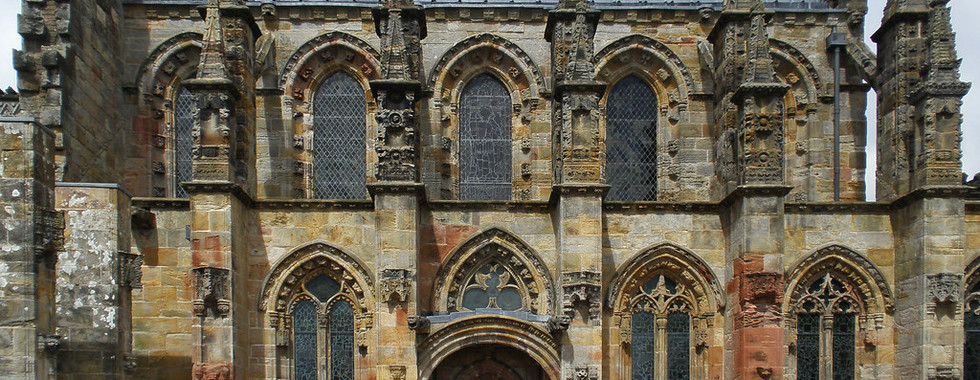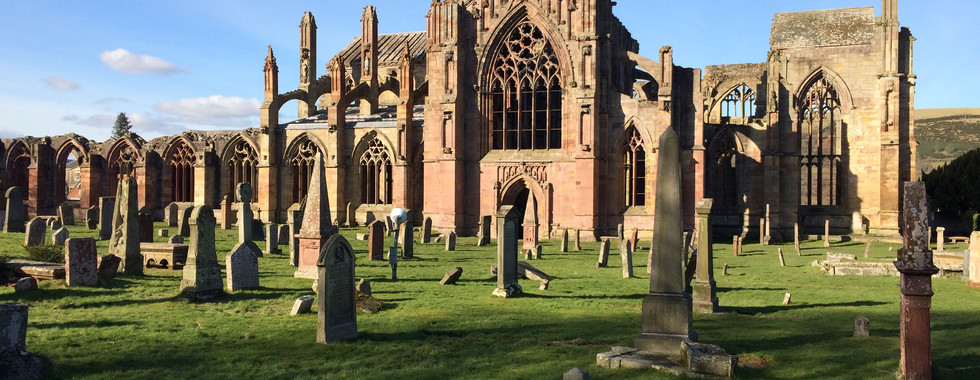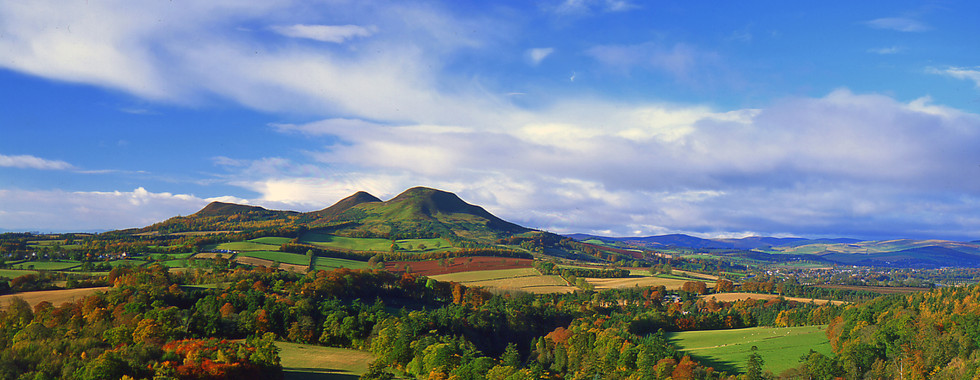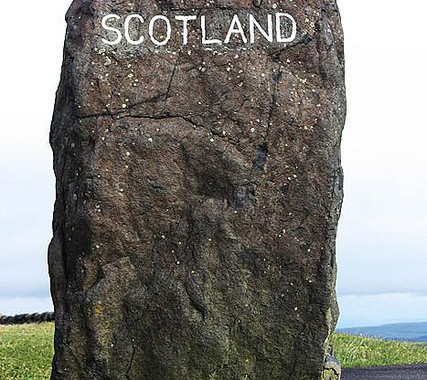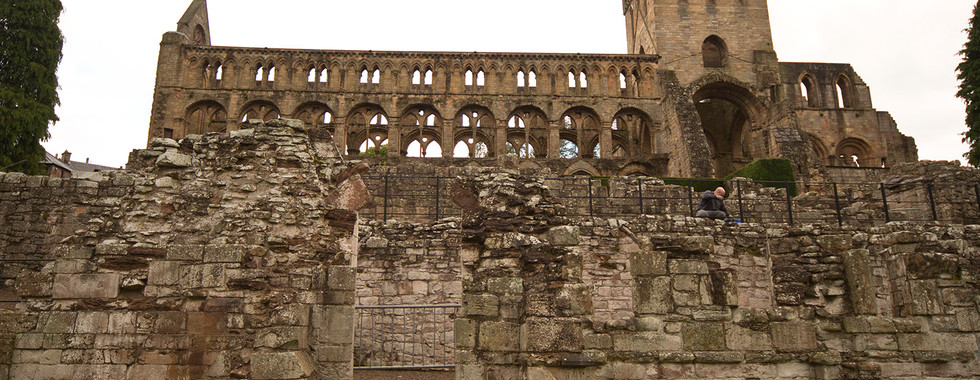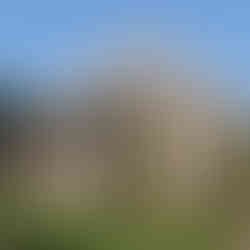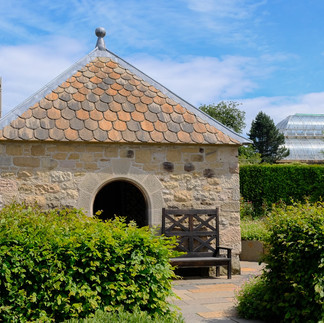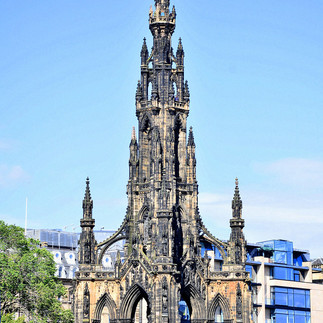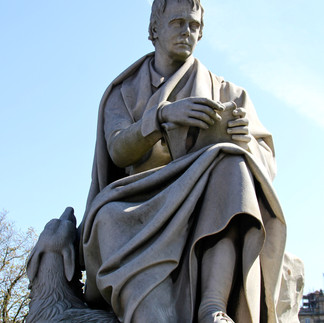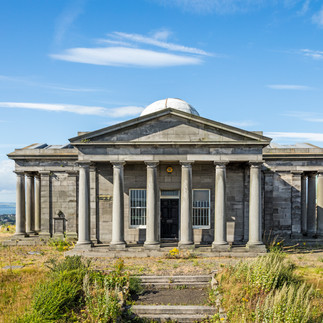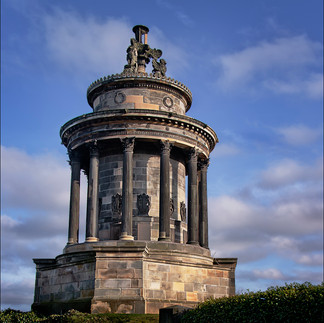Nearly every weekend at Harlaxton, some sort of trip happened, whether organized by the college or by individuals. Most trips were just two days, but a few organized trips took place over a four-day weekend. The first of these longer trips took place at the end of January. However, while most students packed their bags and boarded coaches to explore Scotland, I stayed behind. I would have loved to go on the trip, but I didn't have the finances to, especially given I would be spending the next semester studying in France.
So, instead of walking the streets of Edinburgh or hiking along Hadrian's Wall, I worked on assignments and hung out in the common spaces with others who had stayed behind.
The spirit of the Manor is quite different when the halls aren't filled with students. Your footsteps echo a bit more, and your thoughts seem to take up more space than they do otherwise. This particular quiet weekend, my thoughts were on travel. While my friends were traversing the border between England and Scotland, I dreamed up plans of where I would go, what I would see, what I would eat, and what I would do if I were to visit the land of the Scots. Here follows that dream 2-week vacation I hope to one day complete.
Days 1-2: Edinburgh

My imagined 2-week trip starts and ends in Edinburgh. When I travel, I am usually most interested in cultural and historical sites and sites that show the natural beauty of the place I am visiting. As the capital of Scotland, Edinburgh certainly has plenty of all three.
On the first day, I explore the Old Town, starting at Edinburgh Castle, one of the oldest fortified palaces in Europe. After walking around the grounds and the museums it houses, I move on to St. Giles' Cathedral. Founded in 1124, the Cathedral has seen and undergone many changes, including the Reformation. The most recent change was adding a stained glass window memorial to Robert Burns, a Scottish poet and National Bard. Next, after lunch and a bit of shopping along The Royal Mile, I finish the day's touring at the Writer's Museum. Edinburgh was the first UNESCO City of Literature, so it's only natural to spend some time appreciating writers, poets, playwrights, and bards. The museum focuses on the lives and works of Robert Burns, Sir Walter Scott, and Robert Louis Stevenson, featuring portraits, rare books, and personal objects.
Day two takes me a bit further afield to Arthur's Seat for a morning hike. Arthur's Seat is an ancient volcano with excellent views of the city; it also the site of a fort that dates back 2000 years ago. Some say that it could be a possible location of King Arthur's castle, Camelot (though I more readily believe that the name actually derived from Scotts-Gaelic). After coming back down from the 251m peak, I head to the Palace of Holyroodhouse and the ruins of Holyrood Abbey. Palace Holyroodhouse is the Royal Residence in Scotland, and the Abbey is just one part of the grounds that you can visit, along with 14 State Apartments and the royal gardens. The Palace was the home of Mary, Queen of Scots, and the setting for the so-named 2019 Universal Pictures biographical film. The second day then ends with a bit more history at the National Museum of Scotland.
Days 3-5: Glasgow

From Edinburgh, I travel east toward Glasgow, stopping by Falkirk and Stirling to see Stirling Castle and The Kelpies sculpture and take a ride along the canals and see the Falkirk Wheel.
The next two days are spent touring Glasgow, starting with a morning at the Kelvingrove Art Gallery and Museum on day one. The Gallery and Museum was first opened in 1901 and, today features a wide range of artworks and artifacts, including works by Dali, Monet, Rembrandt, Titian, Gaugin, and Renoir. Nearby the Museum, there is also a large park with a fountain memorializing the Lord Provost Robert Stewart, credited as establishing the first permanent freshwater supply system for Glasgow from Loch Katrine. The fountain also depicts imagery from Sir Walter Scott's poem, "The Lady of the Lake."
With a morning well-spent viewing art, I pause for lunch and an afternoon river cruise starting at the Riverside Museum, followed by an afternoon at the Glasgow Botanic Gardens. The gardens are quite expansive, with several greenhouses and a rose garden.
Glasgow is widely known for its live music scene, so day one ends with dinner and a concert. The Old Fruit Market is one popular music venue. It started as a fruit market but today hosts musical events of all kinds in its unique venue with vaulted ceilings and wrought iron columns and balconies.
The second day in Glasgow starts at the Glasgow Cathedral. It is the oldest building in Glasgow and the oldest cathedral in mainland Scotland - at least the oldest still intact after the Reformation. The site of the cathedral is also where St. Kentigern is thought to be buried. After viewing the 13th-century cathedral, I head to Merchant City, stopping by George Square, where the City Chambers and several monuments and statues - including those to Robert Burns, James Watt, Sir Robert Peel, and Sir Walter Scott - are located. Merchant City itself is an area with many shops and restaurants and a large number of murals that have even been put into a walking tour of the city center. Also along the Mural Trail are a few other historical sites, including The Lighthouse. The Lighthouse's building was originally the offices for the Glasgow Herald and was built in the late 1800s. Now, it houses Scotland's Centre for Design and Architecture. Inside, you can head up to the viewing platform, and if you're not afraid of heights, you can climb the spiral stairs.
After lunch and some shopping, I finish up with an afternoon in the Glasgow Green, a large municipal part along the River Clyde. The visit to the park would start at the McLennan Arch. The arch was originally part of the building of a social club during the 1800s and was preserved when the building was torn down to make room for a post office. After several moves, it made its way to its present location as one of the entrances to the Glasgow Green. The next stop in the green would be the People's Palace, a museum featuring exhibits of the social history of Glasgow. In addition to the plethora of historical artifacts, the museum also houses a cafe and winter gardens, though the gardens are unfortunately closed to the public indefinitely. The rest of the park features plenty of green space, several statues and monuments, and athletic fields.
From here, I enjoy some dinner and perhaps see another music event, possibly at a live music pub like The Ferry, which turned an old ferry into a kitchen, bar, and music venue.
Day 6: Scottish Highlands: Loch Lomond, Inveraray Castle, and Oban

I venture into the wild Scottish Highlands from Glasgow, with my first stop being at Loch Lomond. According to the Park's website, the loch is part of a greater National Park - the Loch Lomond and the Trossachs National Park - and is actually the largest stretch of inland water in Britain. The Loch is quite popular and well known, even being featured in the traditional folk song "The Bonny Banks of Loch Lomond," so it's no wonder that there are quite a number of visitors each year. If you want to listen to the song, check out the music video created by Ella Roberts of YouTube (it's a beautiful rendition and video):
Of course, the real reason why the Loch is so popular is because it is quite beautiful, as are the surrounding hills and mountains. There are many other lochs and hiking trails to explore in the Park, so one can certainly spend a good amount of time at this stop. However, I continue on after a morning by the loch to Inveraray for lunch and a tour of Inveraray Castle. Besides being a filming site for the series Downton Abbey, Inveraray Castle is a beautiful castle and the ancestral home of the Duke of Argyll. It is located on the shores of Loch Fyne. Visitors can tour the halls as well as the gardens, an extensive gallery of which can be found on the website.
After lunch, I come down from the Highlands to the coastal town of Oban. The town's name means "little bay" in Gaelic, and from here you can take ferries to explore the Hebrides islands: Kerrera, Lismore, Mull, the Morven peninsula, Iona, Coll, Colonsay, and Tiree. Aside from the islands, there is much to see closer to the town, including Dunollie Castle ruins, the Oban Distillery, and McCaig Tower.
Day 7: Western Coast: Glencoe, Fort William, and Mallaig

Continuing through the Highlands, I move up the western coast, first stopping in Glencoe. In addition to being surrounded by many trails into the mountains, Glencoe was the filming site for some of the scenes in Outlander, Monty Python, Highlander, and Harry Potter. In particular, Hagrid's hut was set up in the hills around Clachaig's Gully.
After an easy hike near Glencoe, I would stop next in Fort William for lunch and a trip up the Nevis Range Gondola. Like Glencoe, the area around Fort William has been the background for many films. The flying car scene in Harry Potter? That was filmed at the Glenfinnan Viaduct. Other films filmed here include Braveheart, Highlander, and Skyfall. And it's no wonder; Ben Nevis, the highest peak in the British Isles, attracts more than 125,000 visitors each year.
Having taken in the views, the evening finds me in the port town of Mallaig, where I would spend the night. In the morning, I board a ferry to the Isle of Skye.
Days 8-9: Isle of Skye

The ferry from Mallaig arrives at the southern end of the Isle of Skye, an island that has lone been a part of Scottish lore and mythology. And it's no question as to why: the largest island of the Inner Hebrides, its often mist-shrouded shores welcome you to an island with wild landscapes and enchanting scenery.
My first stop on the island is Armadale Castle, located a short walk from the pier. The Castle is the former home of the MacDonalds of Sleat, part of the Clan Donald. The clan ruled the western coast of Scotland for nearly 400 years and is said to have controlled an empire powerful enough to challenge Scottish kings. Even today, it remains a large and influential clan with over 40 tartans associated with the name and numerous members throughout the Scottish diaspora. My own family has some Scottish ties (Stuart and Bruce clans, including Bonnie Prince Charles, apparently), though most of my ancestors are from England and Wales. In any case, Armadale Castle is now in ruins, and, although you cannot enter the ruins due to them being unstable, you can walk through the gardens and other areas of the expansive estate run by the charity group Clan Donald Lands Trust.
The Sleat peninsula juts south from the rest of the Isle, so to see sites like the Fairy Pools, Cuillin Hills, and Elgol, you first must travel north to Broadford. Broadford is the second largest town on the Isle and is a sort of transportation hub as it is the first stop across the Skye Bridge from Kyle on the mainland and the connection between the Sleat peninsula, Elgol, and the rest of the Isle. Here is where I stop for lunch before going back south to Elgol.
On the way to Elgol, you pass through the Red Cuillin mountains. The Cuillin Range is the mountain range that occupies most of the island. Myths state that the two mountains - Black Cuillin and Red Cuillin - were formed when the Sun's spear pierced the ground. Soon, a blister formed, and its eruption created Black Cuillin, whose molten material spread and softened, forming Red Cuillin. Clearly, the ancient Scots were describing the volcanic activity. From the hamlet Elgol, you can take a ferry ride across Loch Scavaig to Loch Coruisk, where the Back Cuillin mountains are visible.
The last stop for the afternoon is the Fairy Pools, just on the other side of the Black Cuillin Mountains, which means that if you don't want to spend all day hiking through the mountains, you'll need to pass back through Broadford and around the Cuillin Range. If you are interested in hiking through the Cuillin Range, the website Walk Highlands has details of various hikes you take, including their difficulty, throughout the mountains of Scotland. The Fairy Pools, as the name would suggest, are also steeped in myth and legend. Legend states that one of the MacLeod chiefs married a fairy princess, giving rise to many places named after the "wee folk." The Fairy Pools themselves are also said to a popular sunbathing spot for Selkies - Orkney mythological seals who shed their skins to become human. Many of the myths around Selkies involve human men stealing the seal skins of Selkie women and forcing them to be their wives, though once the women find their seal skin, they promptly return to the ocean. Aside from their fairy lore, the pools are a beautiful spot, a fairly easy hike, and a magical place for swimming if you can brave the cold waters.
From the Fairy Pools, I head to Portree, where I will spend the next two nights. There is not much to see in the town of Portree itself aside from The Lump, which is a peninsula on one side of the bay with a 19th-century watchtower and panoramic views. The town, though, is often the home base for visitors to the Isle, as it is the largest town and another hub.
My second day on the island explores more of the northern side, starting with Dunvegan Castle. The Castle has been the ancestral home of the MacLeod Clan for over 800 years and is actually still inhabited. With such a long history, you can only imagine the changes the Castle has seen as time has gone marching on. The structure has details from at least 10 different building periods from the 1200s to the 1850s, and there are many artifacts inside the castle that speak to its long history - and its legends. One such artifact is the Fairy Flag. Several myths surround the origins of the flag, though one of the more popular stories involves a fairy wrapping a MacLeod baby in a fairy blanket when he had kicked off his own blanket while sleeping. Today, the Fairy Flag remains one of the MacLeod's most treasured possessions. Also to see at the Castle are the gardens which occupy 5 acres of land and include a Water Garden, Rose Garden, Walled Garden, and woodland spaces. You can read more about the castle on their website.
After touring the castle and grounds, I head further north to the Old Man of Storr, a rock formation atop the Storr's rocky hill. The hike to the rocks is just under 90 minutes, though it is classified as medium difficulty. It is one of the most photographed locations on the Isle of Skye and results from a massive ancient landslide, though the myths tell a different story. Two different stories, actually. The first legend states that the Old Man of Storr was a giant who lived in the region. When he was buried, his thumb protruded from the ground, which created the rocky cliffs. The other story states that a Brownie carved the two rocky spires in memory of his friend, a man who saved his life, and his wife after they died.
My last stop before returning to Portree for the night is the Fairy Glen. It certainly has a magical look about it, hence the moniker. There is a rock formation called Castle Ewan in the glen, which you can climb for some great views.
Day 10: Eilean Donan Castle, Loch Ness, and Inverness

With a tour around the Isle of Skye complete, I head back to the mainland, traversing across the Skye Bridge to Kyle of Lochalsh and the Eilean Donan Castle. The castle was first inhabited in the 6th century, though built and rebuilt several times. The current castle is a restoration of the ruins left after a Jacobite uprising partially destroyed it in 1719. More of the castle's history can be found on their website. Continuing with our Scottish mythology and legend thread, Eilean Donan Castle is another place where it is said Selkies can be spotted.
From Eilean Donan Castle, my travels take me further north to Loch Ness and Urquhart Castle. In all honesty, a trip to Scotland doesn't seem complete without visiting Nessie's home. Nessie is, of course, the affectionate nickname of the Loch Ness Monster, another creature of Scottish lore. Many stories are surrounding the creature that supposedly lives in the freshwater loch. However, some say it may just be a Kelpie, a mythological water horse known to lure unsuspecting children onto its back and then drown them. The Kelpies sculpture in Falkirk is another reference to these malevolent spirits. Whether Nessie is truth or legend, its home, Loch Ness, is quite beautiful and home to Urquhart Castle. The Castle stood as a medieval fortress for over 500 years until it was blown up during the Jacobite Uprising. The ruins, though, still overlook the loch and are a great vantage point for visitors.
Not far from Loch Ness is Inverness, which has its own castle and is where I stay for the night. Inverness Castle was originally built in the 11th century but was eventually rebuilt after the Jacobite Uprising. Today's neo-Norman structure is located at the end of Great Glen and overlooks the River Ness. The castle is also referenced in Shakespeare's Macbeth, which featured several castles in Scotland's northern part. Inverness Castle is where Macbeth's castle is located before he becomes King. It's also where Duncan is killed.
Day 11: Castles of the North-Eastern Coast

Castles are found all over Scotland. In fact, there are nearly 2,000 of them throughout the mainland and isles. Many of these castles are located in the northeast, particularly in Aberdeenshire, which, according to the National Trust for Scotland, "has more castles per acre than anywhere else in the UK." They form the Castle Trail, and to me, it seems a Scottish Loire Valley, minus the wineries. I will visit several of these northern castles on my way to Aberdeen, the first being Cawdor Castle. This is, of course, the castle alluded to in Shakespeare's Macbeth as the residence of the thane of Cawdor, which Macbeth becomes after killing Duncan. Macbeth also dies on a battlefield supposedly near the castle. The castle dates back to the 14th century. Visitors can tour the castle, though some may find it quite different from the imaginings of the Shakespearean castle, including the thorn tree that grows in the tower guard room. Legend says that the tower was built around the tree after the Thane dreamt of the location. There are also ghost stories associated with the castle, though none are of the Shakespearean ilk.
The next castle stop on the way to Aberdeen is Brodie Castle. Built in the 16th century, Brodie is a turreted castle with a garden that features over 400 varieties of daffodils. The castle is pink in color, likely due to granite stones, and houses many artifacts, including a Pictish stone known as the Rodney Stone. There are also stories connecting the castle to Macbeth - be it the real Macbeth or the fictional one from Shakespeare's rather embellished retelling of Scottish history. A nearby hill known as Macbeth's Hillock is rumored to be where Macbeth first met the three Witches.
My final stop on the way to Aberdeen is Kinnaird Head Castle. The castle was first built in the 1500s for the Fraser family and was then altered to include a lighthouse in 1787. You can walk up the steps to the top of the lighthouse for a good view of the rocky coastline and peruse the Museum of Scottish Lighthouses at the castle. With part one of the castle viewing complete, I arrive in Aberdeen for the evening.
Day 12: Aberdeen

Day 12 of my trek around Scotland is spent in the coastal town of Aberdeen. I start my day around Aberdeen at Aberdeen Beach for a sandy stroll before heading to St Machar's Cathedral in the Old Town. The Cathedral is built on the site of a place of worship from the 6th century, and a stone with a Celtic cross - believed to be one from the original place of worship - is displayed in the Cathedral. Legend also says that William Wallace's left arm is buried in the Cathedral walls after his hung, drawn, and quartered. Then, during the Reformation, the Cathedral became a cathedral no longer, passing into the hands of the Presbyterian Church.
A short walk from the church is the University of Aberdeen, where the 16th-Century King's College Chapel is located. Atop its tower sits a stone Imperial Crown, and the interior has some of the finest woodwork in Scotland, including 52 medieval choir stalls and screens. After a fairly relaxed and spiritual morning, it's time for lunch, perhaps at one of Aberdeen's many seafood eateries such as The Silver Darling situated right along the bay.
Just on the other side of the bay from The Silver Darling is the Torry Battery. The artillery defended the harbor for over 150 years, including during the First and Second World Wars. It's also a popular place for dolphin watching.
The rest of the afternoon is spent in the central part of town, walking past the white facade of Marischal College to wandering the exhibits in the Aberdeen Art Museum to viewing the Wallace Memorial in the Union Terrace Gardens just in front of His Majesty's Theatre. The Theatre is my next stop after dinner to enjoy a performance, a pleasant ending to a full day.
Day 13: Eastern Coast: Stonehaven, Dundee, and St. Andrews

I leave Aberdeen to continue down the eastern coast, stopping to view more of Aberdeenshire's castles. The first stop is in Stonehaven, a small seaside town known for the ruins of Dunnottar Castle. The ruins were once the home of the Keith family, though they saw many changes of hands and purposes. Besieged, destroyed, and burnt numerous times, the Castle was once a Pictish fort, a house of worship, a fortress, and a prison.
Making my way further down the coast, I head toward Dundee, stopping at another castle - Glamis Castle - on the way. Glamis, another inspiration for Shakespeare's Macbeth where King Malcolm is murdered, has been the ancestral home to the Earls of Strathmore and Minghorne since the 14th century in the morning and the childhood home of Her Majesty Queen Elizabeth the Queen Mother. The nearby town of Dundee has been dubbed a City of Design by UNESCO, and there is certainly quite an array of architecture to see: from the modern V&A Dundee to the Victorian Gothic McManus Art Gallery and Museum, to the 15th century Broughty Castle, to the 19th century Malmaison building. So much so, in fact, that there is an official tour course of 27 prominent buildings: the Dundee Architectural Trail. After seeing a few buildings on the trail and eating lunch, I move on down the coast to St Andrews for the remainder of the afternoon before arriving back in Edinburgh.
There are quite a few things to see and do in St. Andrews, one of being to explore the ruins of St Andrews Castle, which date to the 13th century. The ruins stand atop sea cliffs, and the castle actually has a rather bloody past. During the Reformation, the underground dungeon was used to imprison Protestants, and the castle also became the site of numerous executions. After the Reformation, the castle fell into ruin, and several parts were lost to the sea as the cliffs eroded. It's regrettable how much history was lost during and after the Reformation.
Another ruin to see in St. Andrews is St Andrews Cathedral. Once the largest Cathedral in Scotland, it was established in 1160, and the tower, which still stands, was part of the first Augustinian Church. Like many other Catholic churches and cathedrals, St Andrews Cathedral was partially destroyed during the Reformation and left to fall into ruin afterward. Today, the ruins still give a sense of the enormous presence the Cathedral once had, and visitors can tour a small museum on the site as well.
Days 14-15: Edinburgh, Once More

The final two days of the two-week romp around Scotland are back in Edinburgh, starting with a day trip to a few sites along the border with England, including the remnants of Hadrian's Wall. For this particular stretch of the trip, I join a group tour organized by Heart of Scotland Tours because it is a bit further afield. The tour begins with a visit to the 15th century Rosslyn Chapel. The Chapel features many stone carvings, many of which are still not understood, and because of inspiration for The Da Vinci Code. Theories on the origins of these carvings bring about rumors of the Knights of Templar and the Freemasons. The next stop on the bus tour is Melrose Abbey, which is believed to be the final resting place of King Robert the Bruce's heart. After lunch near the Abbey, the tour crosses over the border with England to visit the Roman ruins of Hadrian's Wall and Housesteads Fort. The tour then turns back toward Edinburgh, making a final stop in Jedburgh to view the Abbey.
The final day in Scotland is a little less busy, beginning with a walk in the Royal Botanic Garden Edinburgh. The Garden has a history of 350 years and is a national treasure of Scotland. The garden contains an Arboretum with more than 3,500 trees from 730 different species, a vast array of rhododendrons, a rock garden, a woodland garden, a Chinese garden, the Queen Mother's memorial garden, a greenhouse, an alpine house with plants from arid regions, a biodiversity garden, and a demonstration garden. With such extensive grounds and so much to see, it's quite easy to spend the whole morning here. Thankfully, there is also a cafe and restaurant on-site for a bite to eat before heading toward the city center and the Scottish National Gallery.
On the way to the gallery, I pass by the Scott Memorial. The memorial to Sir Walter Scott stands along Princess Street and is one of the largest memorials to a writer worldwide. You can even climb to the third-floor observatory for views of the city after learning more about the monument in the museum room on the first floor. It is a stunning piece of Gothic architecture.
The early afternoon is then spent at the Scottish National Gallery viewing works of art created by many great artists, including Vincent Van Gogh, Salvador Dali, Sir Henry Raeburn, Samuel John Peploe, and Joan Eardley. Leaving the gallery, I walk through Old Town to the
UNESCO World Heritage Site, Calton Hill. The hill offers panoramic views of Edinburgh from the Pantheon-inspired National Monument. Also on the hill is the Nelson Monument, the Burns Monument, and the City Observatory. The view - and sunset - is a perfect way to end my final day in Scotland.








